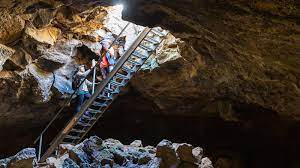Boyd Cave

Beneath the surface of the Earth lies a hidden realm, a mysterious world that captivates the imagination of adventurers and spelunkers alike. One such marvel is Boyd Cave, a subterranean wonder located in the heart of the Deschutes National Forest in central Oregon. This natural masterpiece beckons intrepid explorers to unravel its secrets and marvel at the intricate formations that have been sculpted over thousands of years.
Table of Contents
ToggleDiscovery and History
Boyd Cave wasn’t always a popular destination for adventure seekers. In fact, it remained largely undiscovered until the mid-20th century. The cave owes its name to William Boyd, a local rancher who stumbled upon its entrance in 1957 while searching for stray cattle. Intrigued by the opening in the ground, Boyd ventured inside, unveiling a mesmerizing world hidden beneath the surface.
Following its discovery, Boyd Cave went through a period of relative obscurity. It wasn’t until the 1990s that the cave gained recognition and protection as part of the Deschutes National Forest. The U.S. Forest Service, in collaboration with local caving organizations, worked to preserve the delicate ecosystem within the cave and make it accessible to the public.
Geology and Formation
Boyd Cave is a lava tube, a geological formation created by the cooling and solidification of molten lava during volcanic eruptions. The cave’s origin can be traced back to the Central Oregon Pumice Plateau, an area with a rich volcanic history. As lava flowed across the landscape, it left behind tunnels and chambers that now form the intricate network of passages within Boyd Cave.
What sets Boyd Cave apart is its well-preserved features, showcasing various types of lava formations. The cave is a testament to the geological forces that shaped the region, providing a unique opportunity for scientists and enthusiasts to study the Earth’s natural processes.
Exploring the Depths
Entering Boyd Cave is like stepping into another world. The entrance leads to a series of chambers and passages adorned with mesmerizing stalactites and stalagmites. The eerie silence, interrupted only by the occasional drip of water, adds to the otherworldly atmosphere within.
Guided tours are available for visitors, led by experienced cavers who provide insights into the cave’s geology, history, and the unique ecosystem that has adapted to the subterranean environment. Explorers navigate through narrow passages, squeeze through tight crevices, and marvel at the intricate formations that have evolved over centuries.
Unique Fauna and Flora
While the cave might seem inhospitable at first glance, it is home to a variety of unique organisms that have adapted to the challenging conditions. Some species of bacteria and fungi thrive in the darkness, utilizing the limited nutrients available to sustain life. Microscopic invertebrates, such as springtails, have also been discovered, showcasing the resilience of life in unexpected places.
The cave’s ecosystem is fragile, and visitors are reminded to tread lightly and follow strict guidelines to minimize human impact. Conservation efforts aim to preserve the delicate balance within the cave, ensuring that future generations can continue to witness its natural beauty.
Preservation Challenges and Efforts
Preserving Boyd Cave poses unique challenges due to its delicate environment. Human activity, even with the best intentions, can have lasting effects on the cave’s ecosystem. To address these concerns, the U.S. Forest Service and local conservation groups have implemented measures to protect Boyd Cave.
Access to the cave is carefully regulated, with guided tours providing a structured and educational experience for visitors. Strict guidelines are in place to prevent the introduction of contaminants, and efforts are made to minimize the impact of tourism on the fragile formations.
Educational Opportunities
Beyond its aesthetic appeal, Boyd Cave offers valuable educational opportunities for students, scientists, and amateur geologists. The cave provides a living laboratory for the study of geology, biology, and environmental science. Educational programs and workshops are conducted to foster a greater understanding of the Earth’s processes and the importance of cave conservation.
School groups often visit Boyd Cave, guided by knowledgeable interpreters who share insights into the geological history of the region and the unique adaptations of cave-dwelling organisms. These educational initiatives contribute to a broader awareness of the importance of preserving natural wonders like Boyd Cave for future generations.
Conclusion:
Boyd Cave stands as a testament to the Earth’s geological wonders, inviting adventurers to explore its hidden depths. From its humble discovery by a rancher in the 1950s to its current status as a protected natural site, the cave has undergone a remarkable transformation. Today, it serves as both a scientific treasure trove and a mesmerizing destination for those seeking to connect with the mysteries that lie beneath our feet.
As we delve into the subterranean world of Boyd Cave, we are reminded of the delicate balance between exploration and preservation. The awe-inspiring beauty of the cave is a reminder of nature’s ability to create wonders in unexpected places, and the responsibility we bear to ensure their continued existence. Boyd Cave invites us to step into the darkness, not only to witness its beauty but also to appreciate the importance of conservation in safeguarding our planet’s hidden gems.






